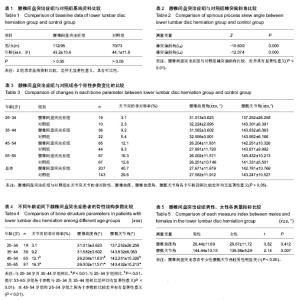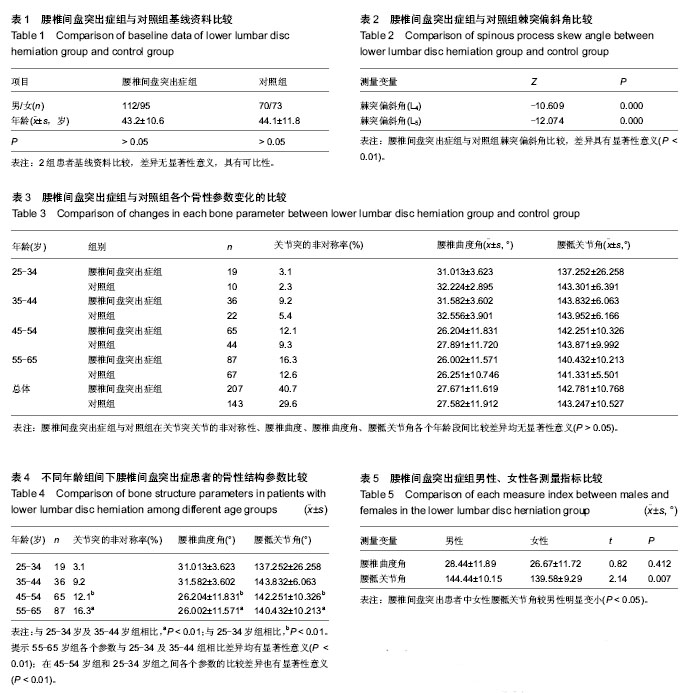| [1] Tischer T, Aktas T, Milz S,et al.Detailed pathological changes of human lumbar facet joints L1-L5 in elderly individuals.Eur Spine. 2006;15(3):308-315.
[2] Van Schaik JP. Lumbar facet joint morphology. J Spinal Disord. 2000;13(1):88-89.
[3] Niosi CA, Oxland TR.Degenerative mechanics of the lumbar spine.Spine J. 2004;4(6):202-208.
[4] 谭映军,潘显明,张波,等.腰椎间盘摘除前后椎间关节腔内应力变化的实验研究[J].骨与关节损伤杂志,2001,16(1):31-32.
[5] Berven S, Tay BB, Colman W, et al. The lumbar zygapophyseal (facet) joints: a role in the pathogenesis of spinal pain syndromes and degenerativespondylolisthesis. Semin Neurol. 2002;22(2):187-196.
[6] 胡有谷.腰椎间盘突出症[M]. 北京:人民卫生出版社,1995: 221.
[7] Van Schaik JP, Verbiest H, Van Schaik FD.The orientation of laminae and facet joints in the lower lumbar spine.Spine (Phila Pa 1976). 1985;10(1):59-63.
[8] Ishihara H, Matsui H, Osada R, et al.Facet joint asymmetry as a radiologic feature of lumbar intervertebral disc herniation in children and adolescents.Spine (Phila Pa 1976). 1997;22(17): 2001-2004.
[9] Hellems HK, Keats TE.Measurement of the normal lumbosacral angle.Am J Roentgenol Radium Ther Nucl Med. 1971;113(4):642-645.
[10] 程延,张丽心,杨富国,等.腰椎间盘突出症发病的生物力学基础研究进展[J].现代中医药,2002, 22(1):35-37.
[11] 盂庆兰.腰椎上关节面方位角变化规律及其临床意义[J].中国临床解剖学杂志,2002, 20(4):283.
[12] Cassidy JD, Loback D, Yong-Hing K,et al.Lumbar facet joint asymmetry. Intervertebral disc herniation.Spine (Phila Pa 1976). 1992;17(5):570-574.
[13] 黄友锦,卓启瑶,丁中平,等.腰椎间盘突出症腰椎关节突关节的CT分析[J].实用放射学杂志, 2003, 19(4):373-374.
[14] 卢定友,顾建华,孙维高,等.下腰椎小关节突方向非对称性与椎间盘突出方向关系的研究[J].临床放射学杂志,2003, 22(4): 343-344.
[15] 黄建华,陈金春,徐卫国. 腰椎关节突关节角不对称与椎间盘变性的相关性[J].中医正骨,2006, 8(18):27-29.
[16] 赵平,冯天有.腰椎力学结构失衡与椎间盘突出的发病[J].中医正骨,1993, 5(3):37-39.
[17] Posner I, White AA 3rd, Edwards WT,et al.A biomechanical analysis of the clinical stability of the lumbar and lumbosacral spine. Spine. 1982;7(4):374-389.
[18] 陆裕朴,胥少汀,葛宝丰,等.实用骨科学[M].北京:人民军医出版社, 1991: 1150.
[19] 金柏军,钱宇,徐国健.下腰痛患者与腰椎前凸度及骶骨倾斜度的关系[J].中国脊柱脊髓杂志,2004, 14(6):364-365.
[20] Ahsan MK, Matin T, Ali MI, et al. Relationship between physical work load and lumbar disc herniation. Mymensingh Med J. 2013;22(3):533-540.
[21] Seidler A, Bolm-Audorff U, Siol T, et al. Occupational risk factors for symptomatic lumbar disc herniation; a case-control study. Occup Environ Med. 2003;60(11):821-830.
[22] van der Windt DA, Simons E, Riphagen II, et al. Physical examination for lumbar radiculopathy due to disc herniation in patients with low-back pain. Cochrane Database Syst Rev. 2010;(2):CD007431.
[23] Zhou SH, Yang J, Meng QG, et al. Relationship between effect of sacral canal injection and different sections, types, courses of lumbar intervertebral disc herniation. Zhongguo Gu Shang. 2013;26(7):580-583.
[24] Takashima H, Takebayashi T, Yoshimoto M, et al. Efficacy of diffusion-weighted magnetic resonance imaging in diagnosing spinal root disorders in lumbar disc herniation. Spine (Phila Pa 1976). 2013;38(16):E998-1002.
[25] Zhang YG, Zhang F, Sun Z, et al. A controlled case study of the relationship between environmental risk factors and apoptotic gene polymorphism and lumbar disc herniation. Am J Pathol. 2013;182(1):56-63.
[26] Tufan K, Sen O, Cekinmez M, et al. Comparison of E-selectin and the other inflammatory markers in lumbar disc herniation: a new promising therapeutical window for radicular pain. J Spinal Disord Tech. 2012;25(8):443-446. |

